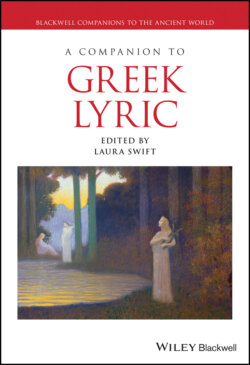Читать книгу A Companion to Greek Lyric - Группа авторов - Страница 38
VIII Love and War 2: Sappho fr. 44
ОглавлениеBut perhaps the most well-known reframing of an apparently epic story in lyric modality comes in Sappho fr. 44, which tells the story of the wedding of Hector and Andromache. The extant portion of the text opens with Idaios apparently announcing the imminent arrival of Andromache, and is then concerned with the preparations to receive her and the following celebrations in Troy.42 Once typically classed as one of Sappho’s epithalamia (“wedding-songs”) though it refers to no contemporary wedding, this poem exploits both that convention and its dactylic rhythm to produce the most recognizably “epic” of archaic lyric poems before Stesichorus. A stichic poem adding to the epic resonance, each of its verses contains an invariable number of syllables (fourteen) with a strong dactylic rhythm (× × ‒ ˘ ˘ ‒ ˘ ˘ ‒ ˘ ˘ ‒ ˘ ‒). This allows many epic features, on the level of meter (e.g., line 5, where -[ο]ι is shortened before ἄ- in an instance of “epic” correption, a prosodic feature not usually found in Aeolic lyric), language (κλέος ἄφθιτον 4),43 and narrative convention: the story proceeds in a strictly sequential manner, there is an unparalleled (at least from our examples above) use of character speech with a closing “formula” (4–11; for ὢς εἶπ’ cf. Homeric ὣς φάτο etc.), a catalog of Andromache’s dowry (7–10) and even a refraction of the typical epic departure scene (13–20).
Unsurprisingly, scholars have tried to link this poem with the Iliad, casting it as a foreboding pastiche-prediction of the couple’s future within, and predicted by, the epic.44 Certainly Homer knew the story but other epics, such as the cyclic Cypria and whatever preceded it,45 might have told it, alongside the wedding of Helen and Paris (already encountered in Sa. fr. 16 and Alc. fr. 283). Equally, some scholars have viewed the poem in positive terms, as a joyous celebration of the couple’s limited but still glorious future.46 Yet epic weddings are not generally happy affairs,47 and the marriage inevitably invokes the fall of Troy and the death of their son Astyanax, both popular themes in early epic,48 which sits ill with the apparent purpose of an epithalamium, even one which is something of a generic oddity.
Aside from the question of sources, fr. 44 is typically Sapphic in its emphasis on the experience and perspective of women: Andromache’s praise (8–10) looks forward to the joyful Trojan women participating in the ceremonies (14–16, 23–31), the couple’s “imperishable glory” (4) is equally hers as it is Hector’s, while the promise and value of her person, augmented by the dowry-catalog but also the detailed, itemized description of the whole city’s welcome, contrast powerfully with Troy’s unstated future. As Sappho reframes the epic world, the female presence within it becomes as prominent and visible as the male.
So the lyric experiment and interaction with epic in the Archaic period consisted of several strategies of engagement, and several opportunities for poetic choice: appropriation and alteration of language, form, rhythm and prosody, theme and material, immediate or self-sufficient directionality in orientation, in sum the—at times, deliberately and openly agonistic—subordination of epic poetry and its modality to the needs of the lyric poet.
